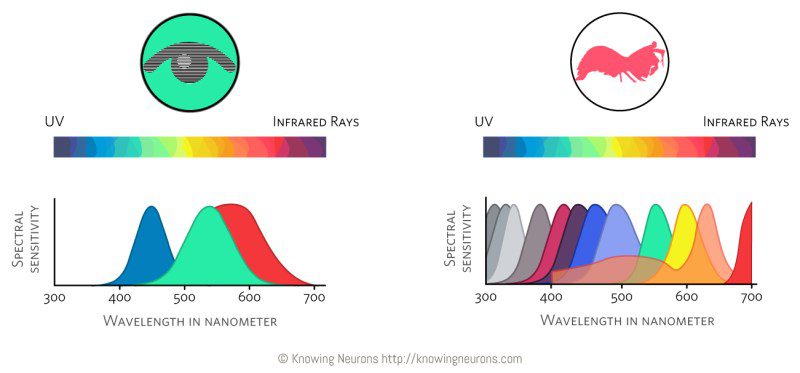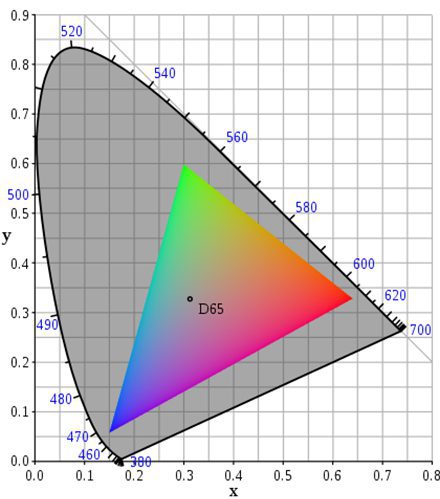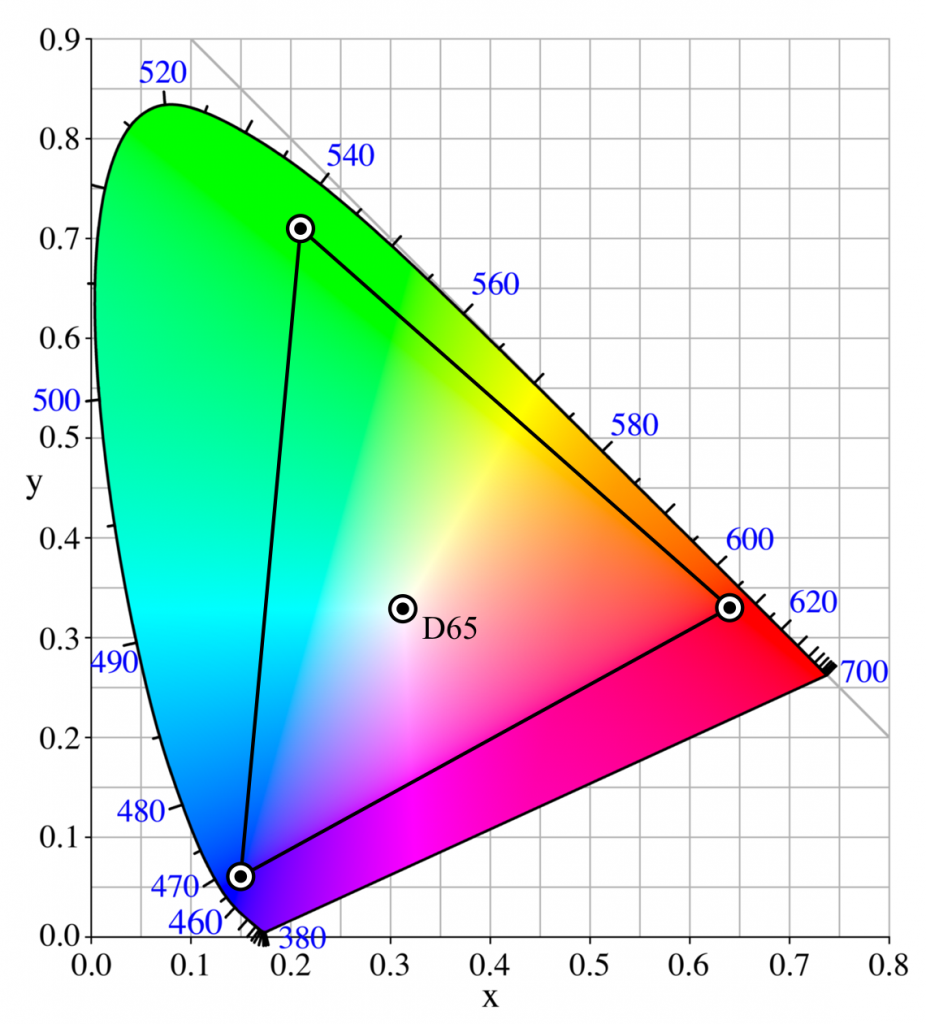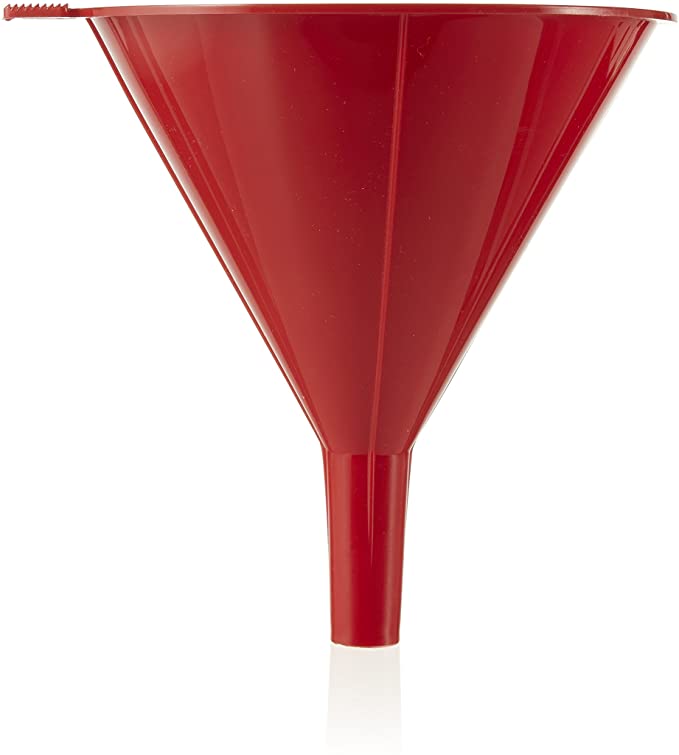Let’s face it, making slick videos or breathtaking photos ain’t easy. To pull off images that impress, you need a solid understanding of framing, lighting and a dozen other factors. However, few things are as vital for success as an understanding of color space, also known as color gamut.
Whether you’re printing your photos or uploading video to YouTube, understanding the role of color space from capture to publication is crucial. It will influence the way you shoot on set and the way you set up your photo or video editing workstation.
But what is color space? And what’s the difference between these two color spaces you keep hearing about: sRGB vs Adobe RGB?
Keep reading to learn more about color space in the first section. Then, continue on to find an answer to a very common question – which color space should I be using: Adobe RGB vs sRGB?

What is ‘Color Space’ and Why Does it Matter?
Stated simply, the color space of a device refers to the range of colors that device can support. Monitor/screen technology is still playing catch-up to the human eye. We see a much wider range of colors than any monitor can display.
To illustrate what color space means, let’s look at a couple living examples. Some animals can see more colors than others due to the structure of their eye. For example, human eyes have 3 photoreceptors which gives us this beautiful world we see. But the mantis shrimp has 12 photoreceptors! Can you imagine the insane variety of color a mantis shrimp sees?

No, actually you can’t. That’s the answer.
Color gamuts can be thought of in a similar way. In the world of color spaces, the color width of sRGB is metaphorically closer to the human end. And the color width of Adobe RGB is closer to the mantis shrimp.
But before we get to sRGB vs Adobe RGB, here are a few more important points on color space.
First, a camera captures footage in a specific color range. For some cameras, this color range is an adjustable setting. For example, in the Sony a7sii that I own, I can easily toggle between both color spaces.
Once images are captured on a digital camera, it’s time to upload them to a computer. There, your monitor displays the footage in a specific range of colors. The file from your camera has information on it telling reading devices, like a computer, what colors are present.
If the range of colors in the footage is too wide for the screen (Adobe RGB footage on an sRGB monitor, for example), then you won’t be able to view the full range of colors originally captured.
There are several color spaces worth knowing. But for this post, we’re focusing on the two most popular color spaces. As mentioned above, Adobe RGB is wider (displays more colors) than sRGB.
And, as you might guess, some monitors portray colors more accurately than others.
So, before you decide on which color space you’ll capture your images in, it is important to know how those images will be used at the end. If you’re shooting video for YouTube, use sRGB since YouTube uses a color space nearly identical to sRGB. But, if you’re shooting for a printed movie poster, Adobe RGB might be the better option.
And if you’re shooting a big budget film, you’ll use DCI-P3, the movie theater standard.
But let’s not make this confusing.
If you want to see a simple breakdown of the major color spaces, check out this post on important photo and video editing monitor specs. Or, scroll to the bottom of this post for recommendations on which color space to use.
If you want to dive deeper into color gamuts, I recommend this blog. Because I’m no pro, I needed help to understand color space. Jonny Elwyn was extremely insightful and thorough in the linked post.
Next, let’s focus on the question of the hour: should you use sRGB or Adobe RGB color spaces?
Which is Better: sRGB vs Adobe RGB
Trying to answer which color space is “better” is difficult. As you’ll see, each has its pros and cons. The simple answer is that Adobe RGB is theoretically better… but that doesn’t mean you should use it.
Adobe RGB footage (shot, edited and viewed properly) will display a wider variety of colors than sRGB. But, for most uses, sRGB is totally acceptable. After all, sRGB is the most common color space of average monitors and TVs. And for many editors, the extra steps involved in working with this wide color space properly can be cumbersome. If those important post-production steps aren’t taken, your Adobe RGB footage could end up looking worse than it would have in sRGB.
Plus, it’s important to understand that many monitors don’t even fully display either of these color gamuts. Take a look at this list of the best monitors for video editing. You’ll notice that many of the very best video editing monitors display a high (but often less than 100) percentage of sRGB. And they generally display even less of Adobe RGB.
Next, let’s get into specifics about each of these major color gamuts. But first, let’s do some ground work. Specifically, let’s see what color space is!
What is “Color Space”?
Color space is a simple concept to grasp. Essentially, color space or color gamut in photography/videography refers to the range of colors that a device records or displays. That’s it! Take a look at this post for a deeper dive into color space basics.
What is sRGB?
sRGB can be considered a “default color space”. Hewlett-Packard developed sRGB color space in 1996 and it eventually became the standard of RGB color spaces. At the time, computers were becoming a thing and digital producers needed one standard color that everyone could rely on. sRGB was selected.
Most consumer devices, web applications and social media still utilize on the sRGB color space. It’s extremely common and it looks pretty good! sRGB covers roughly 35% of the colors a human eye can see.
Below is an image depicting the range of colors sRGB covers.

What is Adobe RGB?
As you might have guessed from the name, this color space was first developed by Adobe Systems in 1998. Adobe RGB was created specifically with print in mind. It uses the CYMK (cyan, yellow, magenta and black) space.
As I say in the final section of this article, the CYMK space is most relevant in printing. So, it’s a good space to use if you’re working with CYMK printers.
All Adobe products have the ability to handle Adobe RGB and it covers approximately 50% of the colors a human eye can see.
As you can see from the image below, this color space covers way more color than sRGB. But, the Adobe RGB gamut is much less common when it comes to displays like TVs and monitors. And keep in mind, having the right software to work with Adobe RGB is essential for getting the most out of it.
So, not only will you need gear capable of capturing and displaying this very large color space, but you’ll need to make sure your editing tools are also capable.

As mentioned, answering which color space is best is difficult. It depends on the individual project, the skill level of the editor and the final output. Instead of addressing which color gamut is best, let’s answer a more useful question – which color space should I use, sRGB or Adobe RGB?
What to use – Adobe RGB or sRGB?
Now for the star of the show. When people ask which color space is best, they’re really asking “which color space should I use”.
There are 3 basic things to consider when making a decision between each color space:
- Personal preference and skill level
- Equipment capabilities
- Final output
Here are more specific details that can guide decision making in shooting your raw file.
sRGB vs Adobe RGB for MOST Videographers and Photographers
For the majority of videographers and photographers, we do recommend using sRGB. One reason is because Adobe RGB requires additional knowledge and gear. Using this wide gamut requires extra steps in post-production to get everything looking as good as it can look.
And, importantly, most platforms the average creative will be uploading content to use a color space that is nearly identical to sRGB. So, even if you do everything right with your Adobe RGB footage, none of that hard work will matter if you’re just uploading to YouTube or Instagram.
For these reasons, MOST videographers and photographers (at least those not operating at the highest of levels) will be totally fine sticking with sRGB throughout the entire process.
But, in case you want more precise recommendations, keep reading.
Shooting Photo and Video – Adobe RGB
Generally, if you have a monitor that is capable of displaying Adobe RGB, you might consider having your camera record in that space.
If you think of the photography and/or videography process as a funnel, this recommendation can make more sense. At the beginning, or the top, the funnel is wide. This represents the wide range of possibilities for your project.
As you shoot your footage, transfer it to your computer and edit, you work down the funnel until you get to the bottom – the final product.

Owners of an Adobe RGB monitor benefit from having this type of raw files because they are getting the most accurate representation of color while they edit. Using our metaphor, editors with Adobe RGB footage have a wider funnel (more possibilities) compared to editors with sRGB.
And, popular photo and video editing software allow editors to convert a project from Adobe RGB to sRGB. So, by shooting in Adobe RGB, you have access to the full range of colors you originally shot in. This means color grading can be more precise and fun. Then, when you’re ready to offload and publish, you can simply convert to sRGB if that’s what makes sense.
HOWEVER… keep in mind that using Adobe RGB adds steps to your post-production process. If you aren’t ready to learn the entire process or prefer keeping things simple, sRGB is definitely the option for you. Mistakes can easily be made when working with this space (at least right now), and for most creators, the time necessary for learning and implementing these steps may not be worth the benefit.
So, while Adobe RGB files provide a wider range of possible colors, they also provide a greater opportunity for mistakes. And, since most publishing platforms work in sRGB space, wider color spaces aren’t necessary except for the most high-level editors.
Now, let’s cover 3 of the most common final outputs for raw file photo and video work.
Publishing to Online Platforms – sRGB
Platforms like YouTube use (essentially) the sRGB colour space. Therefore, it’s important to ensure your final project has been converted to sRGB before uploading. If you upload Adobe RGB photos or video to a social media platform like YouTube, Twitter, Facebook or Instagram, the platform will convert it for you. By converting it yourself before uploading, you can see exactly what your final product will look like on your chosen platform.
Printing – Adobe RGB
Photographers who are printing their photos should absolutely be working with Adobe RGB images. As mentioned above, this gamut was created specifically with printing in mind. Monitors and TVs display color in the RGB space. Printers use the wider CYMK space because it allows for more saturated colors and vibrant printed images.
Film & TV – Neither
If you’re producing content for film or TV and you aren’t up-to-speed on color space, then I don’t know what to tell you. Good luck? Film and TV each have their own standards. Movie theaters use DCI-P3 and TV uses NTSC. Both color spaces are closer to Adobe RGB than sRGB, but with their own quirks.
Check out this diagram to see how the 5 major color spaces differ:

Final Thoughts: Should I Use sRGB or Adobe RGB for Digital Images?
For the vast majority of content creators, sRGB is more than enough in both shooting and editing. It requires less work, it is more common in gear and software, and it is the universal color space for online publishers. True experts may opt for Adobe RGB, but only in certain cases.
It’s extremely important to remember that going with the wide color space opens the door for mistakes to happen if the post-production process is not handled properly.
Basically, unless you are shooting for print media or for film to be shown in movie theaters, the sRGB color range will be more than enough for you. It requires less post processing and you won’t need a super wide gamut monitor to make your digital images look great. Plus, online platforms and web browsers use color values nearly identical to sRGB. So, don’t confuse yourself! And don’t mess up your images in the editing process.
90% of online creators will excel with the sRGB gamut.
So, in conclusion, the decision to shoot Adobe RGB or sRGB comes down to personal preference, skill level, equipment and final output. If you use the guidelines above, you should be able to make the right decision when confronted with this creative choice!
And don’t forget to upgrade your process with a high end color grading software!
